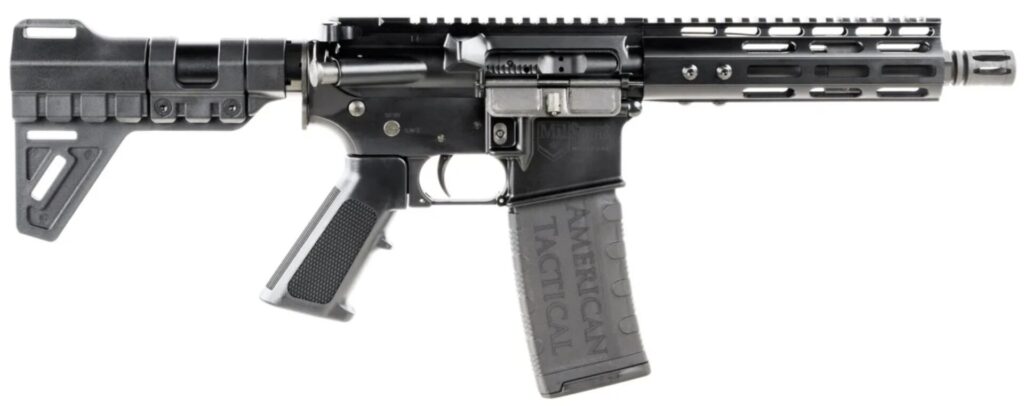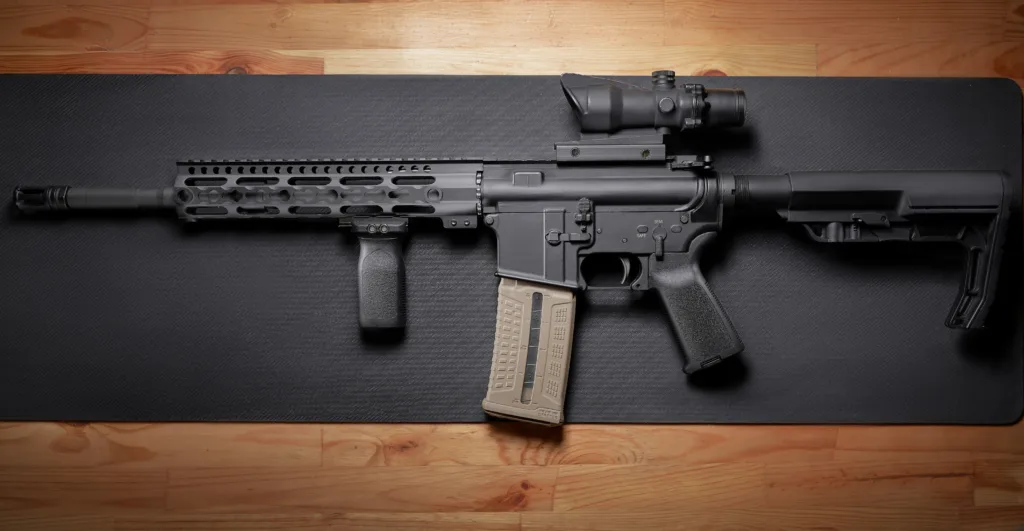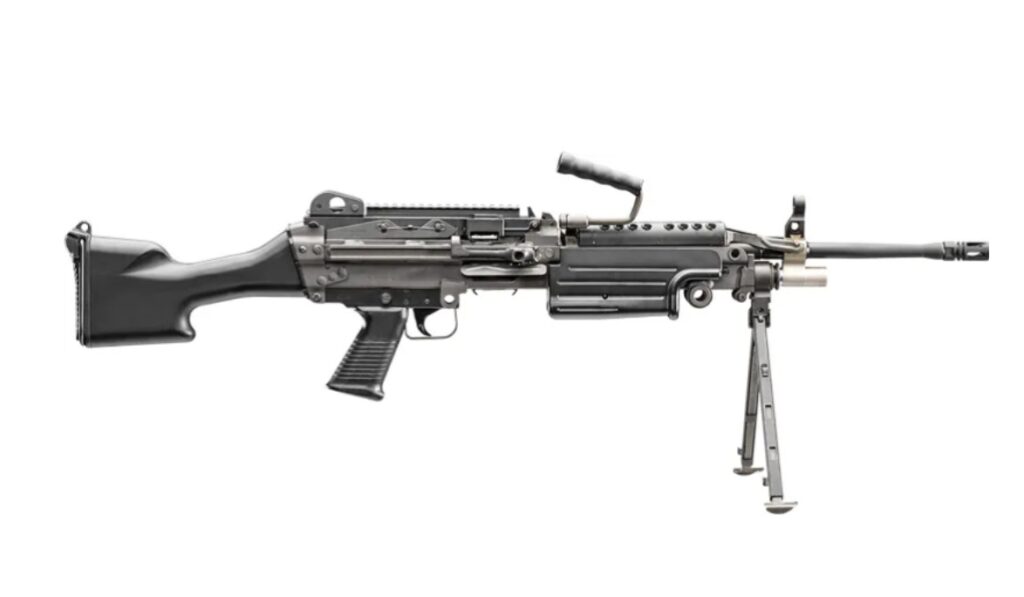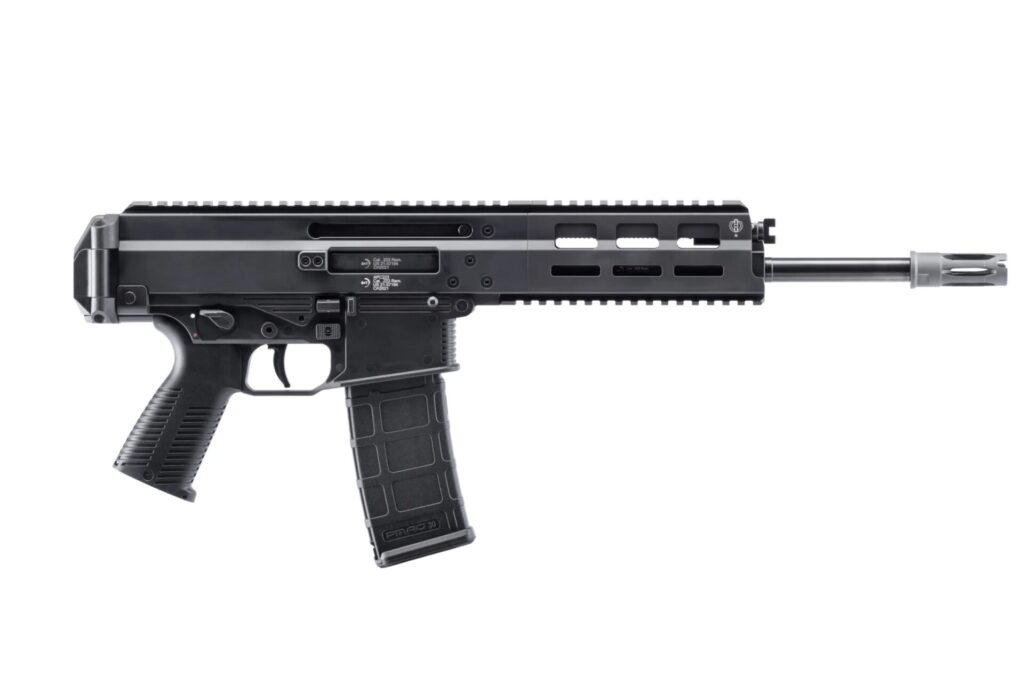Introduction
Choosing between an AR-15 rifle and an AR pistol often leads to a simple conclusion—you probably want both.
But before we start building an arsenal, let’s zero in on the practical reasons why one might be better suited for you than the other.
Whether you’re looking to gear up for long-range target practice or need something compact for home defense, understanding the strengths and trade-offs of each can help guide your buying decision. So, strap in and let’s compare these two firearms with a fine-tooth comb.
Comparing AR Pistols vs AR Rifles
The main difference all boils down to barrel length and the overall size of the firearm. AR rifles typically have a barrel length of 16 inches or longer and come with a stock. This setup results in a sturdier, bulkier firearm. It’s the classic look and feel that many shooters have come to know and appreciate.
AR pistols bring something different to the table with barrels shorter than 16 inches and, rather than a traditional rifle stock, they often employ a stabilizing brace or sometimes no brace at all. This design makes AR pistols notably more compact and easier to maneuver, especially in tight spaces.

Right about now, you might be thinking, “I know this already. If it’s just size and length, can’t I just choose based on whatever feels best in my hand?” And you’re not wrong to think that. Feel and handling are huge factors when it comes to any firearm. But in a minute, we’ll look a bit deeper into how these differences play out in practical terms.
AR Rifles: The Standard Bearer

An AR-15 rifle is what most folks picture when they think about this firearm type. It’s got a 16-inch or longer barrel which provides a couple of key advantages.
First, a longer barrel means a higher velocity as the bullet can spend more time accelerating down the barrel. The increased velocity translates to better range and accuracy, especially at distances beyond 100 yards.
If you like target shooting at the range (or maybe hunting in states where it’s legal to use a centerfire rifle for game), an AR-15 rifle offers the performance you need and more.
The rifle’s size also allows for more space to add accessories, including various AR-15 optics like scopes, bipods, and flashlights along its rail system, not to mention, it usually has better balance and handling due to its length and weight. This can make a big difference in shooting accuracy and comfort during extended shooting.

Of course, not all AR rifles are AR-15s, but the AR-15 is the most well-known and widely used within the broader category of AR (ArmaLite Rifle) platform firearms. The AR-15 specifically refers to a lightweight, intermediate cartridge magazine-fed, air-cooled rifle with a rotating lock bolt, actuated by a direct impingement gas-operated or piston-driven mechanism.
The AR platform includes various models and configurations, each designed for different calibers and purposes. For example:
- AR-10: This is another common model in the AR family, larger than the AR-15 and chambered for full-power rifle ammo—cartridges like the 7.62x51mm NATO—making it suitable for longer-range and hunting applications.
- AR-9: These are AR-style rifles and pistols chambered for 9mm rounds, typically used for personal defense and target shooting due to the lower cost of ammunition and reduced recoil.
- Modern Sporting Rifles (MSRs): This term is often used to describe various semi-automatic rifles that are built on the AR platform but may include modifications and different calibers beyond the traditional AR-15 and AR-10 models.
In short, the term “AR” can refer to a wide array of rifles that share the basic design but differ significantly in their specifications and intended uses.
Still, when most Americans think of an AR rifle, they’re likely picturing the AR-15. This rifle has become emblematic of the AR platform, so if you’re trying to decide between an AR Pistol and an AR rifle, being familiar with the standard features and capabilities of the AR-15 can be a good baseline.
AR Pistols: Compact Power

AR pistols pack a lot of gun into a small package. Note that while there’s not as much room to add on, you can still deck it out with a lot of the same mods you’d use to upgrade an AR rifle.
The shorter barrel makes these guns a good option for shooters looking for something easier to carry and store—perfect for home defense or as a truck gun. With their compact size, they’re also more maneuverable in tight spaces, which can be an advantage in a home defense scenario.
While they do sacrifice some velocity and range due to the shorter barrel, modern ammunition technology has bridged the gap significantly. High-quality defensive ammo is designed to perform well out of shorter barrels, so you’re not losing as much as you might think in terms of terminal performance.
Stabilizing braces have also changed the game. These can help you to fire an AR pistol more accurately by allowing you to strap the gun to your forearm for stabilization. Now of course this isn’t quite as stable as a traditional rifle stock, but it’s much better than firing one-handed.
Depending on where you live, carrying an AR pistol might comply with laws more favorably, especially when it comes to transport and concealed carry scenarios. Always good to check your local laws, but it’s an angle worth considering.
Maintenance
Generally speaking, AR Pistol and AR-15 maintenance isn’t worlds apart—your cleaning kit and routine won’t need a complete overhaul when switching between the two.

Both types will have you spending quality time with your cleaning rod, bore brush, and some good ol’ gun oil. You’ll be doing the regular dance of cleaning the barrel, bolt carrier group, and chamber. Where they start to differ (slightly) is in the details of how you go about it due to their size.
With AR rifles, you’ve got a longer barrel to work with, so there’s a bit more surface area to clean, but it’s straightforward because you can really get in there with your tools without much fuss. AR pistols, though, with their shorter barrels and more compact nature, can be trickier to maneuver around when you’re trying to reach into all the nooks.
Can an AR Rifle Be Converted to a Pistol?
Well, yes, but it’s not as simple as converting an AR rifle into an AR pistol or vice versa, primarily due to legal definitions and regulations.
An AR rifle, by definition, has a barrel of at least 16 inches and includes a stock.
Now, if you start messing with that—say, shortening the barrel to under 16 inches and swapping the stock for a stabilizing brace—you’re entering the area of what legally defines an AR pistol.

But—and here’s the kicker—you can’t legally just convert a registered AR rifle into an AR pistol because of how these firearms are classified and registered under the law, especially considering the National Firearms Act (NFA). If you start with an AR rifle and then decide to go down in size or change significant components, you might end up having to deal with all sorts of legal hoops, like registering it as a new firearm or dealing with tax stamps.
So if you think you might want an AR pistol down the line, it’s usually best (and safest, legally speaking) to start with an AR pistol build or buy one straight off the bat rather than trying to convert an AR rifle into a pistol. It keeps things clean and tidy on the legal front, and you get to avoid any potential headaches with the law.
Bottom Line: Which One to Get?
If your shooting interests lean towards precision and distance, or if you enjoy customizing your firearm extensively, then an AR rifle might be the way to go. It’s versatile and powerful.
But if you want a firearm that’s easier to transport, store, or maneuver in tight quarters, an AR pistol could be a better choice. It’s good for those who live in smaller or tighter living spaces or who just need a firearm that can easily be kept within reach.
In reality, each has its own set of strengths, and the better choice will depend on your specific needs and circumstances.
If you lean towards the rifle for range and precision or the pistol for compact convenience, getting familiar with both could be a good exploration of what the AR platform has to offer.
And here’s a parting shot—no matter if you end up with an AR rifle or an AR pistol, to be effective with it, you need practice and training. Keep your skills sharp, and you’ll enjoy every shot you take.



